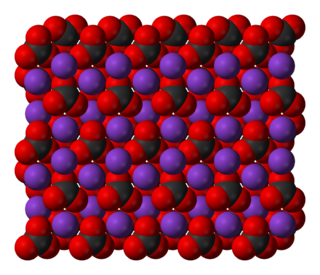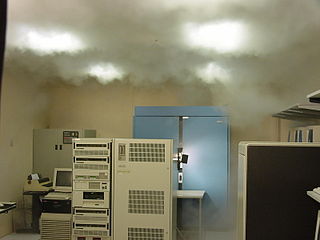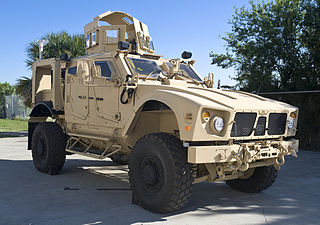Chlorofluorocarbons (CFCs) and hydrochlorofluorocarbons (HCFCs) are fully or partly halogenated paraffin hydrocarbons that contain only carbon (C), hydrogen (H), chlorine (Cl), and fluorine (F), produced as volatile derivative of methane, ethane, and propane. They are also commonly known by the DuPont brand name Freon.

Potassium bicarbonate (also known as potassium hydrogen carbonate or potassium acid carbonate) is the inorganic compound with the chemical formula KHCO3. It is a white solid.

Potassium carbonate is the inorganic compound with the formula K2CO3. It is a white salt, which is soluble in water. It is deliquescent, often appearing as a damp or wet solid. Potassium carbonate is mainly used in the production of soap and glass.

Carbon tetrachloride, also known by many other names (such as tetrachloromethane, also recognised by the IUPAC, carbon tet in the cleaning industry, Halon-104 in firefighting, and Refrigerant-10 in HVACR) is an organic compound with the chemical formula CCl4. It is a colourless liquid with a "sweet" smell that can be detected at low levels. It has practically no flammability at lower temperatures. It was formerly widely used in fire extinguishers, as a precursor to refrigerants and as a cleaning agent, but has since been phased out because of toxicity and safety concerns. Exposure to high concentrations of carbon tetrachloride (including vapor) can affect the central nervous system and degenerate the liver and kidneys. Prolonged exposure can be fatal.

Bromochlorodifluoromethane (BCF), also referred to by the code numbers Halon 1211 and Freon 12B1, is a haloalkane with the chemical formula CF2ClBr. It is used for fire suppression, especially for expensive equipment.
Bromotrifluoromethane, commonly known as Halon 1301, R13B1, Halon 13B1 or BTM, is an organic halide with the chemical formula CBrF3. It is used for fire suppression. Relative to other fire suppressing agents, such as bromochloromethane, it is far less toxic.

Aerosol spray is a type of dispensing system which creates an aerosol mist of liquid particles. It is used with a can or bottle that contains a payload and propellant under pressure. When the container's valve is opened, the payload is forced out of a small hole and emerges as an aerosol or mist. As propellant expands to drive out the payload, only some propellant evaporates inside the can to maintain a constant pressure. Outside the can, the droplets of propellant evaporate rapidly, leaving the payload suspended as very fine particles or droplets.
Halomethane compounds are derivatives of methane (CH4) with one or more of the hydrogen atoms replaced with halogen atoms (F, Cl, Br, or I). Halomethanes are both naturally occurring, especially in marine environments, and man-made, most notably as refrigerants, solvents, propellants, and fumigants. Many, including the chlorofluorocarbons, have attracted wide attention because they become active when exposed to ultraviolet light found at high altitudes and destroy the Earth's protective ozone layer.
A fire retardant is a substance that is used to slow or stop the spread of fire or reduce its intensity. This is commonly accomplished by chemical reactions that reduce the flammability of fuels or delay their combustion. Fire retardants may also cool the fuel through physical action or endothermic chemical reactions. Fire retardants are available as powder, to be mixed with water, as fire-fighting foams and fire-retardant gels. Fire retardants are also available as coatings or sprays to be applied to an object.

1,1,1,2,3,3,3-Heptafluoropropane, also called heptafluoropropane, HFC-227ea, HFC-227 or FM200, as well as apaflurane (INN), is a colourless, odourless gaseous halocarbon commonly used as a gaseous fire suppression agent.
Trifluoroiodomethane, also referred to as trifluoromethyl iodide is a halomethane with the formula CF3I. It is an experimental alternative to Halon 1301 (CBrF3) in unoccupied areas. It would be used as a gaseous fire suppression flooding agent for in-flight aircraft and electronic equipment fires.
Fire class is a term used to denote the type of fire, in relation to the combustion materials, that has ignited. This affects the type of suppression or extinguishing materials that can be used. Class letters are often assigned to the different types of fire, but these differ between territories. There are separate standards in the United States, Europe, and Australia.
The Centre for Fire, Explosive and Environment Safety (CFEES) is an Indian defence laboratory of the Defence Research and Development Organisation (DRDO). Located in Timarpur, Delhi, its main function is the development of technologies and products in the area of explosive, fire and environmental safety. CFEES is organised under the Armaments Directorate of DRDO. The present director of CFEES is Rajiv Narang
PhostrEx is a fire suppression agent developed for use in aviation applications to replace halon, a greenhouse gas (GHG). It was developed by Eclipse Aviation for use aboard their Eclipse 500 very light jets as an engine fire suppression system, and is now being marketed to other aviation manufacturers.

A fire extinguisher is an active fire protection device used to extinguish or control small fires, often in emergency situations. It is not intended for use on an out-of-control fire, such as one which has reached the ceiling, endangers the user, or otherwise requires the expertise of a fire brigade. Typically, a fire extinguisher consists of a hand-held cylindrical pressure vessel containing an agent that can be discharged to extinguish a fire. Fire extinguishers manufactured with non-cylindrical pressure vessels also exist but are less common.

Automatic fire suppression systems control and extinguish fires without human intervention. Examples of automatic systems include fire sprinkler system, gaseous fire suppression, and condensed aerosol fire suppression. When fires are extinguished in the early stages loss of life is minimal since 93% of all fire-related deaths occur once the fire has progressed beyond the early stages.

Pentafluoroethane is a refrigerant with the formula CF3CHF2. Although it has zero ozone depletion potential, it has high global warming potential, reported by the United States Environmental Protection Agency (EPA) as 3450 times that of carbon dioxide.

A combat vehicle, also known as a ground combat vehicle, is a self-propelled, weaponized military vehicle used for combat operations in mechanized warfare. Combat vehicles can be wheeled or tracked.

Condensed aerosol fire suppression is a particle-based form of fire extinction. It is similar to gaseous fire suppression. It employs a fire-extinguishing agent consisting of: very fine solid particles as well as gaseous matter. The condensed aerosol microparticles and effluent gases are generated by the exothermic reaction; the particles remain in vapor state until the process of being discharged from the device. Then, it is "condensed" and cooled within the device and discharged as solid particles.

Clean agent FS 49 C2 is an environmentally engineered, human safe, fast extinguishing Clean Agent fire extinguishing gas for gaseous fire suppression installed in a suited fire suppression system. It is a gaseous solution of 60-80% tetrafluoroethane (R-134a), 10-30% pentafluoroethane (R-125) and 10-30% carbon dioxide (CO2). The Clean agent FS 49 C2 is an extinguishing gas mixture that suppresses fire while maintaining breathable concentrations of oxygen in the air. This makes it possible to extinguish a fire with less danger to people in the room at extinguishing concentrations in contrast to pure carbon dioxide (CO2) based fire suppression system which is deadly to humans when released. In the beginning the gas was called Halotron II B/FS49C2 but later only the name FS 49 C2 is used. Former fire chief Einar Gjessing made an article about the product to inform firemen how this gas works in case they need to enter a fire site with FS 49 C2.











